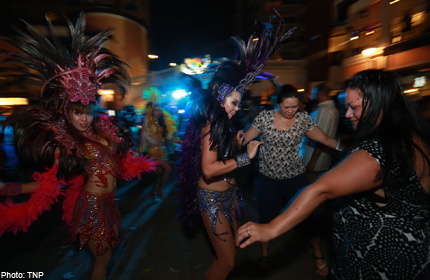
SINGAPORE - The streets burst into colour and came alive at The New Paper Mardi Gras celebration on Friday, held at The Courtyard at Robertson Walk.
Fun and revelry was the order of the day as the street-style party kicked off at 5pm and went on late into the night.
During the Family Fun segment, parents and their children took part in activities like balloon sculpting and face painting.
Mr Dominic Chan, 40, and Ms Sylvia Lee, 44, consultants who work together, were there with their six-year-old son, Isaac, around 6pm.
The family mingled and interacted with the face painters and stilt walkers before joining the colourful Mardi Gras dancers at 7pm.
The couple have been avid readers of TNP for almost 25 years.
"It's part of our lifestyle. It's not pretentious... and very easy to relate to", said Ms Lee of TNP.
They invited about 20 of their friends to the party and enjoyed themselves greatly.

Said Mr Chan: "It's very good and very vibrant. You don't see such events anymore."
Codename for TNP 25 years ago: Project 459 Project
When photojournalist Simon Ker signed up to be part of a new local newspaper more than 20 years ago, he had no idea what the name for the paper was.
"I was just told it was called Project 459," said the 55-year-old.
"Things were really secretive back then because we didn't want competitors to know what we were up to."
Fast forward 25 years and Mr Ker is still with Project 459.
But you would be more familiar with its current name - The New Paper, which celebrated its 25th birthday yesterday with a Mardi Gras bash at Robertson Walk.
"Till today, I have no idea what's the significance of the number 459," said Mr Ker, who is now the photo chief at the paper.
Mr Ker is one of two staff members who have been with the paper since the first issue rolled off the presses on July 26, 1988.
Mr Jonathan Choo, a senior photojournalist, is the other.
"Life was more happening back then and we were really 'garang' (fierce in Malay)," said the 56-year-old.
He recalled a coup in Fiji in 2000, where heavily-armed men stormed the country's parliament, but invited the press into the parliament building.
Recounted Mr Choo, who was there with then-reporter Andre Yeo: "We were not sure whether to go in, because if we did not go in, the only thing we would have were street interviews. But if we went in, we were not sure if they (the armed men) would detain us or kill us.
"In the end, we went in anyway, and got the story and pictures of Andre with the coup leader, (one of) which became the page one picture the next day."
Mr Choo also covered the funeral of Mother Theresa in Calcutta in 1997.
He recounted: "It was a very massive event, where the entire world's media was in attendance. I had to climb a scaffolding where (members of) the local press stepped on my head and hands to keep me off.
"In the end, I shouted 'Singapore' and for some reason, they pulled me up and became very friendly. From that vantage point, I was able to get the shot."
But the newsroom has since moved on, and even though the job remains as challenging, advancements in technology have made the job speedier.
"It used to take hours just to send a photo over because it was on film," he said.
"Now, it takes a few seconds and we can have a wider variety of shots because it's digital."
The TNP brand has also established itself in the consciousness of the people.
Established
"In the past, when we said we were from TNP, people would ask what that was. Now, everyone knows us because the branding has been established," said Mr Choo.
Indeed, TNP's daily circulation has also risen dramatically - from 50,000 when it first started to about 100,000 currently.
TNP also has a Sunday edition, which has a circulation of about 110,000.
Data company Nielsen's Media Index's report last year showed that readership for the print version of TNP was at 459,000.
Mr Ker also remembered some key differences in the newsroom.
"We had more people then, close to 120, compared to about 100 now," he said.
"It was also an afternoon paper and was still partially in black and white."
But the key reason Mr Ker and Mr Choo are still working for The New Paper after all these years is because of the camaraderie and the nature of the job.
Said Mr Choo: "At TNP, no two days are the same, even after 25 years. Every day, I wake up not knowing whether I'll be called to a fire or a fight or even overseas.
"It's the new experiences that keep us going."
Why '459'?
So why was The New Paper called Project 459?
Former president S R Nathan explained it in his memoirs, An Unexpected Journey: Path to the Presidency.
He wrote: "Why '459'? Apparently this was then the postcode for Toa Payoh, which perfectly represented the readership we had in mind."
TNP had aimed to be a paper for the young and the heartlanders, "who preferred to have their news presented in short snippets with a lot of colour", and Toa Payoh "perfectly represented the readership we had in mind".
But Mr Peter Lim, the first editor of TNP, said of Project 459: "I remember that CEO L J Holloway was insistent that we kept the project top secret.
"I didn't know that 459 was the area code for Toa Payoh."

Get The New Paper for more stories.

